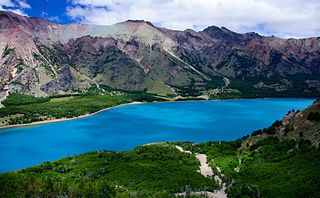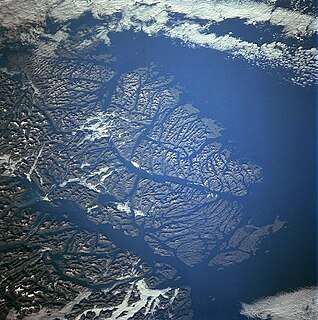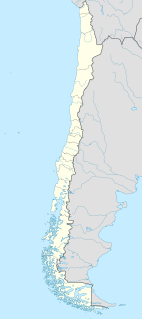
The Aysén del General Carlos Ibáñez del Campo Region, often shortened to Aysén Region or Aisén, is one of Chile's 16 first order administrative divisions. Although the third largest in area, the region is Chile's most sparsely populated region with a population of 102,317 as of 2017. The capital of the region is Coihaique, the region's former namesake.

Govisümber is one of the 21 aimags (provinces) of Mongolia. It is located in the center of the country. Its capital is Choir.
The Picunche, also referred to as picones by the Spanish, were a Mapudungun-speaking Chilean people living to the north of the Mapuches or Araucanians and south of the Choapa River and the Diaguitas. Until the Conquest of Chile the Itata was the natural limit between the Mapuche, located to the south, and Picunche, to the north. During the Inca attempt to conquer Chile the southern Picunche peoples that successfully resisted them were later known as the Promaucaes.

The Chonos Archipelago is a series of low mountainous elongated islands with deep bays, traces of a submerged Chilean Coast Range. Most of the islands are forested with little or no human settlement. The deep Moraleda Channel separates the islands of the Chonos Archipelago from the mainland of Chile and from Magdalena Island.

The Guayaneco Archipelago is an archipelago in southern Chile. It was heavily glaciated during the most recent ice age. These glaciers dissected these mountain islands into a series of deep river valleys and glacial troughs. Today these glacial troughs are deep channels and fjords. The islands of the Guayaneco Archipelago comprise a series of elongated islands and deep bays that are the traces of a drowned coastal range. A number of deep channels are traversing generally north to south through the islands. These include the Messier Channel in the lower left portion of the image, and the Fallos Channel near the center of the image. Forests cover the lower slopes of the mountains throughout the many islands. Human settlement on these islands is scarce.

Tanyderidae, sometimes called primitive crane flies, are long, thin, delicate flies with spotted wings, superficially similar in appearance to some Tipulidae, Trichoceridae, and Ptychopteridae. Most species are restricted in distribution. They are found in many parts of the world, including North America, South America, Africa, Australia, New Zealand, and various islands in the Pacific Ocean. Adults are usually found hanging from vegetation near streams. Larvae are found either in sandy stream margins or in wet, rotten wood. Fossil species are known.

Gulf of Corcovado is a large body of water separating the Chiloé Island from the mainland of Chile. Geologically, it is a forearc basin that has been carved out by Quaternary glaciers. Most of the islands of Chiloé Archipelago are located in the gulf. The area is next to the Chiloé National Park, and a large population of blue whales is found there, and it is under threat from salmon farming.

Presidente Ríos Lake is located in the Aysén del General Carlos Ibáñez del Campo Region of Chile. It lies in the middle of the Taitao Peninsula.
Chonos, one of the Mongolian tribes, can be found in Kalmykia, Buryatia, and the Irkutskaya province in the Russian Federation, and also in Mongolia and the People's Republic of China. The name of the tribe translates as "wolves" or "wolf's", and it is one of the most ancient Mongolian tribes. It is famous as a first tribe which joined Genghis Khan.

The Chiloé Archipelago is a group of islands lying off the coast of Chile, in the Los Lagos Region. It is separated from mainland Chile by the Chacao Channel in the north, the Sea of Chiloé in the east and the Gulf of Corcovado in the southeast. All islands except the Desertores Islands form Chiloé Province. The main island is Chiloé Island. Of roughly rectangular shape, the southwestern half of this island is a wilderness of contiguous forests, wetlands and, in some places, mountains. The landscape of the northeastern sectors of Chiloé Island and the islands to the east is dominated by rolling hills with a mosaic of pastures, forests and cultivated fields.

Guaitecas Archipelago is an archipelago in the Aisén region of Chile. The archipelago is made up of eight main islands and numerous smaller ones. The eight largest islands are from northwest to southeast: Gran Guaiteca, Ascención, Betecoy, Clotilde, Leucayec, Elvira, Sánchez and Mulchey. The islands have subdued topography compared to the Andes, with Gran Guaiteca containing the archipelago's high point at 369 m.

The Chono people, or Guaiteco were a nomadic indigenous people or group of peoples of the archipelagos of Chiloé, Guaitecas and Chonos.
Chono is a poorly attested extinct language of confusing classification. It is attested primarily from an 18th-century catechism, which is not translated into Spanish.
The following lists events that happened during 1837 in Chile.
The Chonos Metamorphic Complex is an accretionary complex composed of metamorphic rocks located in western Aysén Region, Chile. The deposition of the sedimentary protoliths occurred in the Triassic and they were later metamorphosed in the Jurassic. The formation has been subdivided into a highly deformed Western belt and an Eastern belt where sedimentary structures are preserved.

Caleta Chonos Formation is a geological formation of Oligocene age located around Chacao Channel in southern Chile. The formation overlies Bahía Mansa Metamorphic Complex and is overlain by the Ancud Volcanic Complex. It crops out in northwestern Chiloé Island in the isthmus of Lacuy Peninsula.
The Chonide orogeny was a mountain building event in the Triassic, preserved in coastal accretionary complexes in southwestern Chile. The Chonos Metamorphic Complex, Madre de Dios Accretionary Complex and Diego de Almagro Complex all crop out west of the South Patagonian Batholith. Rocks in the Chonos Metamorphic Complex include turbidites as well as meta-chert and mafic schist. Some researchers propose that during the Permian, the supercontinent Gondwana moved rapidly northward leading to the formation of back-arc marginal basins. The closure of the basins then resulted in the orogeny.

The Antonio de Vea expedition of 1675–1676 was a Spanish naval expedition to the fjords and channels of Patagonia aimed to find whether rival colonial powers—specifically, the English—were active in the region. While this was not the first Spanish expedition to the region, it was the largest up to then, involving 256 men, one ocean-going ship, two long boats and nine dalcas. Suspicion about English bases in Patagonia was dispelled by the expedition. Spanish authorities' knowledge of western Patagonia was greatly improved by the expedition, yet Spanish interest in the area waned thereafter until the 1740s.











